Early forms of animations :
The first tool used to produce animations was by a object called the magic lantern. The magic lantern or Laterna Magica is an early type of image projector employing pictures on sheets of glass. It was developed in the 17th century (1650) and commonly used for educational and entertainment purposes. It was invented by Giovanni Fontana who was from all the way back into the 15th century.
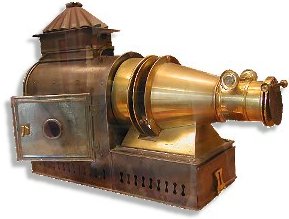
The magic lantern
The second tool that was used to produce animations was a Thaumatrope. A thaumatrope is a toy that was popular in the 19th century (1824). A disk with a picture on each side is attached to two pieces of string. When the strings are twirled quickly between the fingers the two pictures appear to blend into one due to the persistence of vision. The inventor of the thaumatrope is unknown, it’s between john Payton paris or peter mark Roget
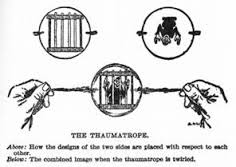
A Thaumatrope
The third tool used to produce animations was the phenakistoscope. The phenakistoscope (also spelled phenakistiscope or phenakitiscope) was an early animation device that used the Persistence of vision principle to create an illusion of motion. The phenakistoscope was made on 1831 by the Belgian Joseph Plateau and the Austrian Simon von Stampfer.
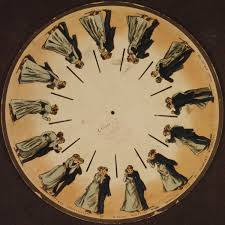
The phenakistoscope.
.The fourth tool used to produce animations was a Zoetrope. A Zoetrope is very similar to a phenakistoscope as it also uses moving images to create film too. The zoetrope had several advantages over the basic phenakistoscope. It did not require the use of a mirror to view the illusion, and because of its cylindrical shape it could be viewed by several people at once.
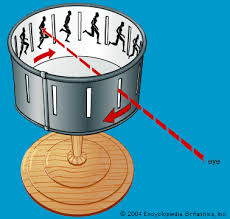
A zoetrope
The fifth tool used to produce animations was a Flip book. A flip book is a booklet with springy pages with each page filled with one part of the animations series located in the unbound edge. The first flip book was created in 1868 by John Barnes Linnet as the kinograph. Here is an example of a flip-book:
The sixth tool used to produce animations was a Praxinoscope. The praxinoscope was created by a French science teacher called Charles-Émile Reynaud, he created the praxinoscope in 1877. The praxinoscope was the first animated projection on a screen.
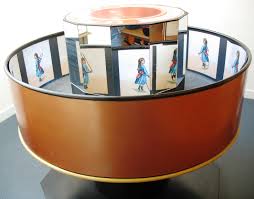
A praxinoscope
Different uses for animations:
Animations are used for many things but its used for entertainment the most, For example it gets used for movies, animations on TV and video games. The very first animated film was called the silent era which was created in 1908 by Emile cohl. through the years animated films have become very popular and produced more as films like Toy story, Shrek, Madagascar and many more have been produced for entertainment.
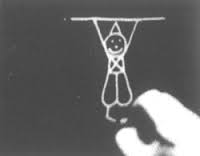
The silent era
TV animations have also been produced a lot for our entertainment as the popularity off animations has got higher through the years, For example there’s a animated TV programme called the Simpsons which has been so successful that it has produced 27 seasons. Animations are becoming so popular that all ages are getting targeted with different programmes, For example: Simpsons are targeting teenagers are there main audiences where animations like south park and family guy target adults as there audience. They use adult humour to make there animations entertaining. There’s also animations like Scooby doo which targets children as there main audience.

Family Guy
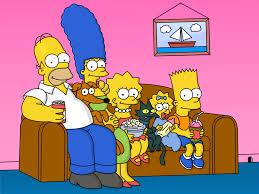
The Simpsons

South Park
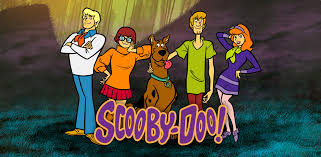
Animations also get used for advertisement over the internet and TV. For example: Butlins 2008 advert contains animations to try make there holiday location look better for family.
As entertainment animations was used in video games as well. the very first animated video game was a game called Dragons liar. This video game was produced in 1983 for the arcades. even in the present day animations are still being used for video games, for example: There’s video games like Naruto and Dragon ball Z.
Animations are also used for education for example many websites with animated games/puzzles to help a student learn quicker. For example there is a website called learning games for kids which is full of animated video games for children to use for there education, helping them learn things they struggle with.

Current trends in animations.
There’s CGI animations. Computer animation, or CGI animation, is the process used for generating animated images by using computer graphics. The visual scenes may be dynamic or static, and may be two-dimensional (2D), though the term “CGI” is most commonly used to refer to 3D computer graphics used for creating scenes or special effects infilms and television
There’s Non-Photorealistic Rendering (NPR):Animation professionals are relying more and more on NPR rather than CG animator. They are using 3D software to create an impressionistic animation that’s similar to hand-drawn media. The best example of this trend is animated movies like Wall and Chains.
There’s the use of the 3D printer. The 3D printer was recently used for a film called the box trolls. a 3D printer is a machine that creates a solid object from a digital file.
There’s the Mixed Styles: This is another trend that has gained popularity in the world of animation recently. The animation here is influenced with western and eastern stylistics. One of the very recent examples is Big Hero 6 that is based on the Marvel Comic about Japanese Super Hero team. Also, lot of western animators are getting influenced by this mixed style.
Software’s used for producing modern animations
- photoshop CS6: Adobe Photoshop CS6 brought a suite of tools for video editing. Color and exposure adjustments, as well as layers, are among a few things that are featured in this editor. Upon completion of editing, the user is presented with a handful of options of exporting into a few popular formats.3ds Max
- mari 2.ov2: Mari, originally developed at Weta Digital for Avatar, is a 3D texture painting application that uses Quadro GPU-acceleration to handle complex, high resolution textures in 3D.unity pro 4
- premiere pro cc:Adobe Premiere Pro is a timeline-based video editing software application. It is part of the Adobe Creative Cloud, which includes video editing, graphic design, and web development programs.
- illustrator cc: Adobe Illustrator is a program used by both artists and graphic designers to create vector images. These images will then be used for company logos, promotional uses or even personal work, both in print and digital form
- CINEMA 4D: CINEMA 4D is a 3D modeling, animation and rendering application developed by MAXON Computer GmbH in Germany. It is capable of procedural and polygonal/subd modeling, animating, lighting, texturing, rendering, and common features found in 3D modelling applications.
- Toon boom studio: Toon Boom Animation Inc. is a Canadian software company that specializes in animation production and storyboarding software. While major animation studios such as Disney, Cartoon Network, Warner Bros. and Nickelodeon use Toon Boom’s professional-grade animation software to create their shows and feature films.
- Maya: Maya, is a 3D computer graphics software that runs on Windows, OS X and Linux, originally developed by Alias Systems Corporation (formerly Alias. | Wavefront) and currently owned and developed by Autodesk, Inc.
- poser pro:Poser is a 3D computer graphics program optimized for 3D modeling of human figures. The program has gained popularity due to allowing beginners to produce basic animations and digital images, and the extensive availability of third-party digital models.
- Sketchbook pro: SketchBook Pro, also referred to as SketchBook, is a pixel graphics software application that features a radial/pie-menu user interface, intended for expressive drawing and concept sketching. It was originally developed by Alias Systems Corporation, but is now owned by Autodesk.
- Mudbox: Mudbox is a proprietary computer-based 3D sculpting and painting tool. Currently developed by Autodesk, Mudbox was created by Skymatter, founded by Tibor Madjar, David Cardwell and Andrew Camenisch, former artists of Weta Digital, where it was first used to produce the 2005 Peter Jackson remake of King Kong.
- digi cell Flipbook: DigiCel FlipBook is 2D animation software that runs on Microsoft Windows or Mac OS X. It is intended to closely replicate the traditional animation process.
- FL studio 11: FL Studio 11 is a complete software music production environment, representing more than 14 years of innovative developments and testament to our commitment to Lifetime Free Updates. Everything you need in one package to compose, arrange, record, edit, mix, master and perform professional quality music.
- Flash professional: Adobe Flash Professional is a multimedia authoring and computer animation program developed by Adobe Systems. Flash Professional is primarily used to design vector graphics and animation, and publish the same for websites, web applications, rich internet applications, and video games.